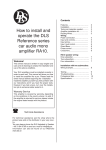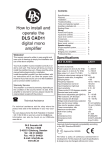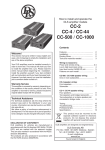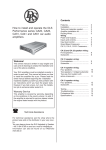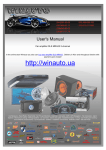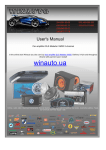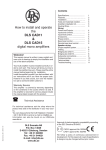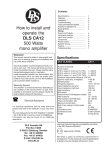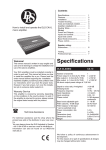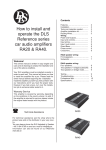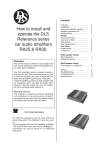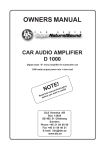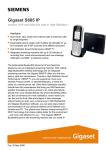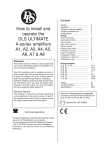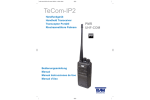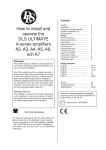Download DLS RA50 Specifications
Transcript
Contents How to install and operate the DLS Reference series 5-channel amplifier RA50 Welcome! This owners manual is written in easy english and uses a lot of drawings to simply the installation and use of the above amplifiers. Your DLS amplifiers must be installed correctly in order to work well. This manual will show you how to install the amplifier like a pro. Please read the entire manual before beginning the installation. Install the amplifier yourself if you feel confident with our instructions and if you have the proper tools. However if you feel unsure, turn over the installation job to someone better suited to it. Warranty Service This amplifier is covered by warranty, depending on the conditions in the country where it is sold. If the amplifier is returned for service, please include the original dated receipt with the product. Technical Assistance For technical assistance ask the shop where the product was sold or the distributor in your very country. You can always phone the DLS Helpdesk in Sweden + 46 31 84 00 60 or send an e-mail to [email protected]. Information can also be found on our WEB-site www.dls.se This manual is modified 2005-04-06 for RA50 with separate sub channel input. Features…………………………….. Installation…………………….……. Tools and materials needed………. Amplifier installation kit………….... Routing Wires…………………….... Wiring: Power connection..……………..…. Input and controls………………..... Input wiring..................................... Hi Level Auto start switch............... Input level control.......................... Grand Bass..................………….... Phase control................................. Crossovers (filters)......................... RA50 speaker wiring: Four speakers + subwoofer ……..... Two speakers in bridge mode + subwoofer.......................................... 2-way component set with active crossover + subwoofer...................... 3-way component set with active crossover to midbass + subwoofer... Testing……………………………….. Troubleshooting……………………... Professional tips…………………….. Specifications………………………... 2 2 3 3 3 4 5 5 6 6 6 6 7-8 9 10 11 12 13 13 14 15 RA50 The amplifiers include RCA inputs High Level input Variable low pass crossover Variable high pass crossover Grand bass feature 0 - +18 dB Phase shift continously variabel 0-180 degr. Remote turn on / off Automatic remote turn on/ off on high level input without connecting any remote wire Electronic protection circuitry against short-circuit, DC offset and thermal overload. Installation Before you begin installation Before you begin you need to read the manual, to have some tools, cables and other material available. There is one such list of material on the following page. Disconnect Battery Before starting the installation, always disconnect the negative terminal of the battery. Amplifier location Important Allow air circulation around the amplifier. The DLS Reference series of amplifiers have a compact design that allows great flexibility in mounting. You can mount it under a seat or in the trunk. When you select a location, do remember that the amplifier generates a lot of heat. Choose a location where air can circulate freely around the amplifier. Do not cover the amplifier with carpets or hide behind trim panels. Do not mount the amplifier in an inverted or upside down position. Check all locations and placements carefully before making any cuts, drilling any holes or making any connections. This is the best way to mount the amplifier to get the best cooling. 2 DLS logo on amplifier cooling flange The DLS logo on top of the amplifier is attached with two hex. screws. The logo can be removed and twisted 90 or 180 degrees, and then screwed back in wanted position. The logo can be mounted in four different ways to match your installation. Use a 1,5 mm hex. key for the screws. RA50 Tools and material needed Tools: Flat and Phillips screwdrivers Wire cutter Wire stripper Electric drill with drills Crimping tool Digital multimeter or test lamp Wire brush, scraper or a piece of an abrasive sheet to remove paint for a good ground connection Grease to protect the ground connection from oxidation Routing wires Stereo head unit Material: Speaker wire: minimum 12 AWG = 4 mm2 for subwoofers 13 – 16 AWG = 1,5-2,5 mm2 for other speakers Sheet metal screws for mounting the amplifier to the amplifier board and the amplifier board to the car + some extra for fuse holder, amplifier ground etc. Electrical insulation tape ½ inch thick plywood or particle board for the amplifier to be mounted upon. Amplifier installation kit: If available,buy an amplifier installation kit. It contains normally all you need. This is what you have to buy if you buy the items separately 20- 25 feet = 6- 7.5 meter power cable, AWG 4 = 21 mm2 or heavier. 1 pc of fuseholder to install close to the car battery + fuse 80-100 Ampere. 20 feet of AWG 15 = 1,5 mm2 wire for remote turn on / off cable from radio. RCA-cable for input from radio. - 20 feet or 5 meter for trunk installations -12 feet or 2 – 3 meter for under seat installations Two ring crimp terminals –one for connection to the battery plus and one for the amplifier ground connection. Four to eight splicers to connect speaker cables to high level input cable, if high level input is used. Wire ties Insulating grommet or insulating tube Professional Tip: If amplifier installation kits are available with different size of power cable, chose the most heavy power cable to improve sound quality and to allow more amplifiers to be installed now or later. If possible use AWG 4 = 21 mm2 cable for best performance. This is for cable lengths up to 5 meters. The ground cable must have the same size. 3 RA50 Wiring Power connections Power terminal ( +12V) Connect the fuse holder as close to the vehicle battery + as possible, using AWG 4 = 21 mm2 or heavier cable. Use ring crimp terminal cable to connect to battery +. Apply silicon grease to the fuse to prevent corrosion. Use an 80 A fuse for cable 4AWG (21 mm2). DLS Connect with ring terminal to battery + terminal DLS FH1 or FH2B fuse holder Connect the battery cable from the fuse holder to the +12 Volt terminal on the amplifier. Be sure to use a rubber grommet or a plastic insulating tube where the cable passes the firewall or other places when it can easily be jammed. Use ty-wraps to secure to existing cables in the engine compartment. Ground Terminal ( GND ) Connect to a good chassis ground. The ground connection should be clean, unpainted metal to provide a good electrical connection. Use a wire brush, a scraper or a piece of an abrasive sheet to clean the metal. Use a lock washer or two to secure contact. Protect with silicon grease or by paint applied afterwards. Remote terminal ( REM ) For RCA cable signal input: Set the input selector switch to position ”Low level”. Connect the radio power antenna lead = remote turn on/off from the car stereo to the amplifier remote connection. This turns on the amplifier whenever the car stereo is turned on. You can either use the built in remote cable in the RCA cable itself or use a separate cable. Sometimes a small disturbance may enter the amplifier coming from the remote voltage , through the built in remote wire and into the RCA cable. Thus we recommend to use a separate remote wire and run the RCA lead separate from remote wire, power cables and speaker cables. Insert the cable directly into the amplifier terminal. If there is no remote voltage available from the stereo, you must connect to the ignition key through the radio or any accessories fuse. Set the ”High level auto start” switch to position OUT. Connect to head unit remote start terminal or power antenna lead For High Level input: Set the input selector switch to position ”High level”. We recommend you to connect the remote wire as described above. The amplifier will produce soft on / soft off operation this way. If you use a remote wire, set the switch ”High level auto start” to position OUT. In the case that there is no remote voltage available from the car stereo, or you want to simplify the installation, the amplifier can be turned on/ turned off by the high level input voltage. This is done when the ”High level auto start” switch is set to IN - position. Connect with ring terminal to chassis ground Fuses Power Light / Protect light Use only three 30 ampere ATC blade type fuses. Power (Green) 30 A 4 Protect (Red) The power light (green ) comes on when the amplifier is turned on. The protect light ( red ) comes on when the amplifier shuts down from DC offset, overheating, or a short circuit ( speaker failure) Input and controls RA50 Input Wiring Inputs may be low level from the RCA output of the car stereo, or high level from the car stereo speaker output. Low level = RCA is to prefer for the best sound quality. Low level input Use a pair of shielded stereo audio cables with RCA type jack. Most trunk-mount amplifiers need a 20 feet RCA cable ( appr 5 – 6 meters). Most under the seat installations require 12 feet ( 2 – 3 meters) RCA cables. Avoid placing the RCA cable close to speaker cables, power cables and remote control cable. Connect to RCA input sockets. Set the input selector switch to position ”Low level”. SUB INPUT selector switch in bottom plate The amplifier has a separate input for the sub channel (CH 5). The signal to the sub channel can either be fed from the input for CH 1 & CH2, or separate through the SUB IN RCA connector. There is a switch under the bottom plate. With this switch in the upper position the sub channel gets it´s signal from CH1 & CH2 inputs. With the switch in lower position, the sub channel (CH5) is fed from the separate SUB input. This is useful if you prefer to use the separate subwoofer output coming from many head units. If your head unit has only one RCA preout, set the selector to the upper position instead. Input Mode Selector CH1 from Input 1 CH2 from Input 2 CH3 from Input 3 CH4 from Input 4 Sub CH5 from Input 1+2 CH1 from Input 1 CH2 from Input 2 CH3 from Input 3 CH4 from Input 4 Sub CH5 from SUB INPUT NOTE! When using high level input the selector must be in it´s upper position to feed the sub channel with signal. High Level Input for ch 1, 2, 3 & 4 Connect left and right speaker wires coming from the car stereo to the high level input as shown. You must connect both plus and minus as the inputs are balanced, connecting plus only gives lower level and bad sound quality. By changing the polarity of plus and minus, you can change the phase. The input signal to the sub channel (CH5) is also fed from the High level inputs if the SUB INPUT selector switch is in the upper position. High level input sockets . CH2 CH1 Hi level input socket on amp. CH4 CH3 Hi level input socket on amp. Green: Left + Black: Left Black: Right Grey: Right + Hi level input plug. Green: Left + Black: Left Black: Right Grey: Right + Hi level input plug. Automatic turn on when using high level input. With the ”Input selector switch” set to High level and the ”High level Auto Start” switch set to IN, the amplifier turns on automatically on high input. You don´t need to connect a separate remote wire from your head unit. If you want to use high level input but use a remote start wire, just set the ”High level Auto Start” switch to OUT. Read more on next page. Hi level / Low level input selector switch To ensure best possible performance from the amplifiers a switch is installed to select between Hi and Low input. When using High Level input: Push in the button to position ”High” When using Low level input: Push out the button to position ”Low” 5 RA50 Phase control Hi level Auto start switch To ensure best possible performance from the amplifiers when used with high level input a switch is installed to select between Automatic amplifier start and remote wire start. The switch is located between the fuses and the speaker terminal. When using High Level input with automatic start: Push the button to position IN When using High level input with remote wire start: Push out the button to position OUT NOTE! Some head units use BTL output IC:s that have a constant 6 Volt + on the speaker terminal, also when shut off (the Power LED indicator lights constantly even when the head unit is off). In this case you have to use a separate remote wire connected to the REMOTE-terminal instead. GAIN 8V 0,5V Play a tape or CD, make sure all bass or treble settings or equalizer are flat, and turn the volume of the radio up until you just start to hear distortion. Turn the volume control down just a bit. On the amplifier increase the input level control ( clockwise or to the right ) until you just start to hear distortion, then back the level control just a bit. Now your radio and amplifier levels are matched. On multi channel amplifiers like theRA50 it´s necessary to adjust the levels indiviually to achieve a good sound balance between the different speakers, different speakers have different sensitivity. When using two of the channels for subwoofer operation, start the level adjustment on these channels. After having adjusted the bass level for good performance, adjust the leve 6 PHASE 0 180 DEGREE Grand Bass 40 Hz Input Level control The input level control, 8V – 0,5 V, matches the output of your radio to the input of the amplifier. After installation is complete, make sure the input of the amplifier is turned down all the way ( counter-clockwise at 8V ). The phase control on the sub channel (CH5) can be set continuously from 0 - 180 degrees. This is very useful when you want to adjust the bass sound for best front stage image. Start on 0 and turn the control slowly clockwise until you experience that the bass sound is coming from the front. If you dont get the result you want, also try to phase reverse the subwoofer connections and make a new adjustment. You can also adjust the phase from the Remote sub level control box Grand Bass is used to increase the bass volume with a center frequency of 40 Hz. You can select the amplification between 0 dB ( no amplification ) and +18 dB (full amplification). This function is used to GRAND compensate for the bass box BASS function and to adjust for your own taste of bass. Set level 0 +18 control at 0 dB if you want it dB to be inoperative. RA50 Crossovers Filters on CH 1 and CH2 The DLS RA50 amplifier include high pass filter (HP), low pass filter (LP) and subsonic filter. The slope of all filters are 12 dB / octave (subsonic 18 dB). The filters can be switched off if you want to run the amplifier in full range mode. Some of the filters can be used on different frequency ranges by the use of multiplication switches. The filter configuration on the respective channels can be found in the technical specifications. High Pass Filter The HP-filter ( high pass filter ) blocks very low frequencies from reaching the speakers. It is mostly used at say 60 Hz to protect small speakers ( like 6 inch and smaller ) from deep bass. HP-filter FREQUENCY 50 140 Hz CH1 and CH2 include high pass filter (HP) and low pass filter (LP). The slope of the filters are 12 dB / octave. The filters can be switched off if you want to run the amplifier in full range mode. The LP-filter can be used in two different frequency ranges by changing a switch in the bottom plate of the amplifer. The switch has two positions giving the following frequency ranges: x1 = 250 - 700 Hz x10 = 2,5 kHz - 7 kHz The LP-filter is used when running a 2- or 3-way system in active mode. See the examples later in the manual. CH1 CH2 LP filter Frequency selector Switches in bottom plate Low Pass Filter The LP-filter ( low pass filter) is mostly used for subwoofers. It will allow low frequencies only and blocks higher frequencies. A typical setting is 50 – 80 Hz. The filter can be switched IN-OUT. The LP-filter on ch 1&2 has another frequency range used for other applications. x1 250 - 700 Hz x10 2,5 - 7 kHz LP-filter FREQUENCY 40 125 Hz The HP-filter is adjustable between 50 - 140 Hz. It blocks very low frequencies from reaching the speakers. It is mostly used at say 60 Hz to protect small speakers ( like 6 inch and smaller ) from deep bass. Subsonic filter The subsonic filter is used to take away the very deepest frequencies from a bass box. The x-over frequency is 25 Hz. IN OUT 7 RA50 Filters on CH 3 and CH4 CH3 and CH4 include high pass filter (HP). The slope of the filter is 12 dB / octave. The filter can be switched off if you want to run the amplifier in full range mode. The HP-filter can be used in three different frequency ranges by changing a switch in the bottom plate of the amplifer. The switch has three positions giving the following frequency ranges: x1 = 50 - 140 Hz x5 = 250 Hz - 700 Hz x50 = 2,5 kHz - 7 kHz The HP-filter is used when running a 2- or 3-way system in active mode. See the examples later in the manual. Switches in bottom plate x1 50 -140 Hz x5 250 - 700 Hz x50 2,5 - 7,0 kHz CH3 CH4 HP filter Frequency selector Remote Bass level and phase control box The amplifier includes a remote control unit. With this unit it is possible to adjust the bass level and phase on the subwoofer channel (CH5), from the front seat. Connect the cable between the amplifier socket and the socket on the remote box. 8 Filters on CH 5, sub channel CH5 include low pass filter (LP) and subsonic filter. The slope of the LP-filter is 12 dB / octave and 18 dB for the subsonic filter. The subsonic filter can be switched off if you dont want any limitation in the lower frequency range. The LP-filter allows low frequencies only and blocks higher frequencies. The filter can be varied from 40 - 125 Hz, a typical setting is 50 – 80 Hz. The subsonic filter is used to take away the very deepest frequencies from a bass box. The x-over frequency is 25 Hz. Grand Bass is used to increase the bass volume with a center frequency of 40 Hz. You can select the amplification between 0 dB ( no amplification ) and +18 dB (full amplification). This function is used to compensate for the bass box function and to adjust for your own taste of bass. Set level control at 0 dB if you want it to be inoperative. The phase control on the sub channel (CH5) can be set continuously from 0 - 180 degrees. This is very useful when you want to adjust the bass sound for best front stage image. Start on 0 and turn the control slowly clockwise until you experience that the bass sound is coming from the front. If you dont get the result you want, also try to phase reverse the subwoofer connections and make a new adjustment. Using the remote level control box you can adjust the phase from the front seat. RA50 Speaker wiring RA50 This is a 5-channel stereo amplifier. It can be connected in various modes described on the following pages. Example 1. Four fullrange speakers connected in stereo mode to front and rear channels, CH1 - CH4 + - - + One subwoofer to CH5 + - Front speaker pair + - - + NOTE! The subwoofer output is 2 ohm stable. Two 4 ohm subwoofers can be connected in parallel. Rear speaker pair Filter settings CH1 - CH2 HP-filter: in OUT position the amplifier allows the speakers to play fullrange. If you for some reason want to limit the low bass reproduction switch IN the HP-filter. The typical setting is then around 60 – 80 Hz. LP-filter = OUT Bottom plate switch: position x1 Filter settings CH5 LP-filter: 60-80 Hz Subsonic filter: position IN For GRAND BASS and PHASE settings, see page 8. Filter settings CH3 - CH4 HP-filter: in OUT position the amplifier allows the speakers to play fullrange. If you for some reason want to limit the low bass reproduction switch IN the HP-filter. The typical setting is then around 60 – 80 Hz. Bottom plate switch: position x 1 9 RA50 Speaker wiring RA50 Example 2. Two fullrange speakers connected in stereo bridge mode to front and rear channels, CH12 & 3-4. One subwoofer to CH5 + - - + + NOTE! The subwoofer output is 2 ohm stable. Two 4 ohm subwoofers can be connected in parallel. Front speaker pair connected in bridge mode Filter settings CH1 - CH2 HP-filter: in OUT position the amplifier allows the speakers to play fullrange. If you for some reason want to limit the low bass reproduction switch IN the HP-filter. The typical setting is then around 60 – 80 Hz. LP-filter = OUT Bottom plate switch: position x1 Filter settings CH3 - CH4 HP-filter: in OUT position the amplifier allows the speakers to play fullrange. If you for some reason want to limit the low bass reproduction switch IN the HP-filter. The typical setting is then around 60 – 80 Hz. Bottom plate switch: position x 1 10 Filter settings CH5 LP-filter: 60-80 Hz Subsonic filter: position IN For GRAND BASS and PHASE settings, see page 8. RA50 Speaker wiring RA50 Example 3 One 2-way component set connected with active crossover. The amplifiers internal filters are used. One subwoofer to CH5 + - - + Woofers + + - - + Tweeters Filter settings CH1 - CH2 - NOTE! The subwoofer output is 2 ohm stable. Two 4 ohm subwoofers can be connected in parallel. Filter settings CH5 HP-filter: in OUT position the amplifier allows the speakers to play fullrange. If you for some reason want to limit the low bass reproduction switch IN the HP-filter. The typical setting is then around 60 – 80 Hz. LP-filter = IN, setting 400 Hz ( x10 = 4 kHz) Bottom plate LP-filter switch: position x10 This setting gives a low pass crossover point of 4 kHz, or use your own setting. Filter settings CH3 - CH4 LP-filter: 60-80 Hz Subsonic filter: position IN For GRAND BASS and PHASE settings, see page 8. HP-filter: in IN position, setting 80 Hz ( x50 = 4 kHz) Bottom plate HP-filter switch: position x 50 This setting gives a high pass crossover point at 4 kHz, or use your own setting. 11 RA50 Speaker wiring RA50 Example 4. A 3-way component set. The midbass connected to CH 1-2 with active crossover. The midrange and tweeters connected to CH3-4 with passive crossover. + - - + One subwoofer to CH5 Mid bass + + Filter box + Filter box + + - - + + - - Midrange Tweeter Filter settings CH1 - CH2 HP-filter: in OUT position the amplifier allows the speakers to play fullrange. If you for some reason want to limit the low bass reproduction switch IN the HP-filter. The typical setting is then around 60 – 80 Hz. LP-filter = IN, setting 400 Hz, or use your own setting. Bottom plate LP-filter switch: position x1 Filter settings CH3 - CH4 HP-filter: in IN position, setting 80 Hz ( x5 = 400 Hz), or use your own setting. Bottom plate HP-filter switch: position x 5 This setting gives a high pass crossover point at 400 Hz, or use your own setting. 12 - NOTE! The subwoofer output is 2 ohm stable. Two 4 ohm subwoofers can be connected in parallel. Filter settings CH5 LP-filter: 60-80 Hz Subsonic filter: position IN For GRAND BASS and PHASE settings, see page 8. RA50 Testing Troubleshooting Before you finish the installation, you should do the following tests to make sure the wiring is correct and everything is operating properly. If problems occour during the installation, or later, this guide might help you to find out whats´s wrong. Reconnect Battery When wiring is complete, reconnect the battery negative terminal. Test power wiring 1. 2. Turn on the head unit but do not turn up the volume. The amplifier power light should come on. If not, check the remote and +12 volt wires. Also check the ground connection. Turn up the head units volume slightly. All speakers should operate. if not, check wiring connections at amplifier and speakers. Test speaker connections Make sure the speakers are connected right. Use the balance control on the head unit to make sure right channel is on right speaker etc. If speakers don´t play at all, one or both speaker wires may be disconnected. THE AMPLIFIER IS DEAD: 1. Check power lead, ground and remote connections at the amplifier using a multi meter. 2. Check the battery terminal connections. 3. Check the power lead fuse or circuit breaker. If fuse damage continues, inspect the power lead for short circuits. 4. Check the amplifier protection fuses. Are these broken change to new ones with the same value. If short circuiting continues, contact your local DLS dealer. A fault may exist in the amplifier. 5. To start the amplifier requires a remote voltage of 9-15 volt. Check the voltage with a multi meter. AMPLIFIER PROTECTION FUSE BLOWS AT LOW VOLUME : 1. One or more speaker cables are shorted. Make an insulation test with a multi meter. The cables must not have a connection to earth. THE AMPLIFIER TURNS OFF AFTER 10 - 30 MINUTES. The amplifier is overheating due to inadequate ventilation. Check mounting position is free from obstruction. Do this: 1. Move the amplifier to a place with better ventilation. 2. Install one or two fans to cool down the heatsink. 3. Overheating can also be caused by an impedance load below the level permitted. NO OUTPUT FROM ONE OR MORE SPEAKERS: Check the following: 1. Balance control position. 2. Fader control position. 3. Speaker cable connections to both amplifier and drivers. 4. Signal lead plugs and cables. 5. Change left and right signal lead plugs in the amplifier to see if the problem moves to a different speaker, the lead has a fault. If the problem remains, the speaker or amplifier are at fault. 13 RA50 Professional Tip: Professional Tip: NOISE PROBLEMS SPEAKER POLARITY CHECK. WHINING NOISE VARYING WITH ENGINE REVOLUTIONS: All speakers in a car audio system should be connected in phase (the same polarity). All speaker cones must move in the same direction. Out of phase speakers will cause a lack of bass, and a poor stereo soundstage. Do this: 1. Rewire the power supply (12 V) to source unit direct from battery. 2. Rewire ground wire from source unit to clean position on chassis. 3. Check all power connections to ensure that they are clean and tight. 4. Check quality of system ground connection. 5. Install a Power Cap capacitor. This can be helpful against most noise problems. CONSTANT WHINING NOISE: Do this: 1. Ensure that all equipment has a common ground point. 2. Check quality of earth strap connection from battery negative terminal to chassis. 3. Disconnect signal cables from amplifier to see if noise disappears. If so the leads are picking up noise. Test this by laying a new cable over the seats and reconnecting to the amplifier. If the noise does not return, reroute original cable away from source of interference. If noise remains regardless of cable position, try to use so called Quasi-balanced signal cables. DLS PRO-cables are Quasibalanced. Professional Tip: Installing in trunk When installing the amplifier in the trunk, run the power wires along the same path as the other vehicle wiring. Many cars have insulated channels for wiring. you will have to remove the door sill trim and the carpet. Checking polarity: Hold the - connection of the speaker wire to the terminal of a 1,5 Volt flashlight battery. Tap the + wire on to the + terminal of the battery, and observe the movement of the cone. The cone should move outwards when the wire touches the battery, and inwards when the battery is removed. If it is the other way around, the speaker has been connected backwards and it must be removed and connected correctly. If your system also has a subwoofer connected through a passive 6 or 12 dB crossover, try to connect this with various polarity and judge what sounds best. The phase shift in passive crossovers sometimes makes it necessary to change polarity. + Battery 1,5 Volt + - NOTE! Tweeters can not be tested this way, double check the connections instead. Professional Tip: Securing wires Use wire ties to bundle together when possible. (But never bundle speaker wires or signal cables together with power wires. Professional Tip: Crimp connections Purchase crimp connectors and crimping tool. Connectors are color coded. 1. Strip 1/4 inch (6 mm) of insulation from the wire. 2. Insert into connector 3. Crimp tightly 14 Professional Tip: Speaker and power wires Do not run speaker and power wires next to each other. Power wires can generate a ”siren” sound in the speakers. Run speaker and power wires on opposite sides of the car. RA50 Specifications DLS REFERENCE RA50 Number of channels 5 Working mode AB Power output at 13,8 Volt, 20 Hz - 20 kHz, max 0,1 % THD, all channels driven. Power output in 4 ohm Power output in 2 ohm THD @1 W Signal to noise ratio, A-weighted Damping factor Frequency response +/- 0,5 dB Input impedance, low level Input impedance, high level High level input with auto start Input sensitivity Filter slope * can be switched Low/High level and Auto Start Pre amp configuration on Front channels: Filter high pass Filter Low pass ** can be switched in/out Pre amp configuration on Rear channels: Filter high pass ** can be switched in/out Pre amp configuration on RA50 sub channel: Filter lowpass Fixed subsonic filter Phase shift 0-180 degrees continously Grand bass adjustable gain @ 40 Hz Remote bass level and phase control *** can be switched in/out 4 x 70 W + 1 x 265 W 4 x 110 W + 1 x 365 W < 0,1% >100 dB >200 10 Hz - 50 kHz >10 kohm* 330 ohm* Yes 0,5 - 8V 12 dB / octave Protection Max cable size, DC input Max cable size, front speakers Max cable size, sub output current, thermal & DC offset 4 AWG, 21 mm2 10 AWG, 6 mm2 7 AWG, 10 mm2 Power consumption: Idle Maximum Fuse Dimensions HxWxD(mm) Dimensions (inch) Weight 1,2 A 90 A 3 x 30 A, ATC-type 59x479x245 2,33x18,855x9,65 5,5 kg / 12,1 lb 50 - 140 Hz** 250 - 700 Hz** (Freq. x 1, x 10 switch) 50 - 140 Hz** (Freq. x 1, x5, x50) 40 - 125 Hz 25 Hz, 18 dB/octave filter slope*** Yes 0 - +18 dB Yes*** NOTE! Channel 1 - 4 amplifiers are 2 ohm stable. You can connect loads down to 2 ohm on each channel. When connecting in mono bridge mode (CH1-2 & CH 3-4) it is possible to connect one 4 ohm speaker on each channel pair. In bridge mode connection an amplifier sees a 4 ohm speaker as a 2 ohm load. The sub channel on RA50 can handle 2 ohm loads, for example two 4 ohm subwoofers in parallel. We follow a policy of continuous advancement in development. For this reason all or part of specifications & designs may be changed without prior notice. 15 DLS Svenska AB P.O. Box 13029 SE-40251 Göteborg, Sweden Tel: +46 31 840060 Fax: +46 31 844021 E-mail: [email protected] www.dls.se
















